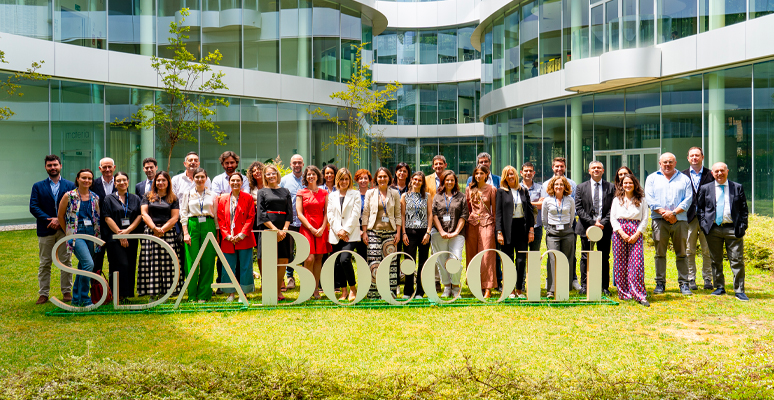
- Start date
- Duration
- Format
- Language
- 12 Nov 2025
- 3 Days
- Class
- Italian
"To train PA managers to make complex decisions, theories and models are not enough: practical cases need to be studied. It's all the better when you can hear them from the voices of their key players," says Silvia Rota, Director of EMMAP, the Executive Master's in Public Administration Management, a program designed for those who work in roles of responsibility for and in PA, which is now in its 13th year.
For this reason, at the conclusion of the module dedicated to Public Governance, Prefect Franco Gabrielli was invited to give a lecture which, as an exception, was also open to outsiders. He told of how he managed a potentially explosive environmental crisis, namely ridding the Island of Giglio and its seabed of the wreck of the ocean liner Concordia, following the tragedy of January 13 ten years ago. This testimony comes as the culmination of a three-day classroom dedicated to consolidating the participants' abilities to read relationships with the environment they operate in and to implement collaborative practices among parties pursuing different purposes, both inside and outside the public perimeter, so as to generate value for the community through ordinary as well as extraordinary management - all of which can be found in the Costa Concordia case. As Eleonora Perobelli, EMMAP coordinator, said at the opening of the event, "the case is even more interesting in light of the nature of these times, dominated by uncertainty, the unexpected and the crisis as a now constant element in public decision-making."
But let's begin with the protagonist. Prefect Gabrielli needs no introduction: a life dedicated to institutions, around safety, security and intelligence policies. His last assignment as undersecretary to the Draghi-led Prime Minister's Office, with the delegation of security, after having served for five years as head of the State Police, preceded by that of Prefect of Rome and, before that, head of the Civil Protection Department, a role he held at the time of the events being narrated. The story of the Costa Concordia is also well known: on January 13, 2012, an ocean liner ended up stranded on the rocks of Giglio Island, and of the more than 4,200 people on the ship, 32 people lost their lives. Between Sept. 16 and 17, 2013, another extraordinary event took place: the ship was righted, using a method that had never before been tried on an ocean liner of this size, namely parbackling, which served to allow the ship to be refloated to the Port of Genoa, where it would be dismantled.
"Yet on the 20th of August, just a few weeks before the start of operations, the Ministry of the Environment sends you a note asking you to submit the decision to authorize parbackling to the Higher Council of Public Construction for its opinion. To us, it seems like a typical case where, just a step away from a solution, someone throws the ball into the stands so as not to take responsibility for a critical decision. What did you do?" asked Raffaella Saporito, EMMAP faculty and former Program Director, during her interview with Prefect Gabrielli. "Granting the request would have meant postponing operations indefinitely: the end of summer was the last useful window, climatically speaking. It was impossible for the Higher Council of Public Construction to give its opinion in a few days." In addition, the project proposal was already the result of an international beauty contest in which the world's top experts on the subject had participated, in which every risk had been evaluated and weighed up, including by the Italian authorities, as part of the initiative promoted by the shipowner in the process of drawing up the proposal for salvaging the wreck. What did this additional technical opinion add, if not to distance the decision and related responsibilities? Thus, the request was not granted and Gabrielli decided not to postpone the operations. It was a brave decision, which transformed the risk of something going wrong during the operations with the commissioner's personal risk of being accused of some form of negligence. "What prompted you to make that decision at the time? In hindsight you were right, but how do you defend yourself against those who try to throw the ball into the stands when you're trying to get things done?" asks Saporito. “It was assessed that things were going well, though not without setbacks." A few days later, in early October, there was a swell that could certainly have sunk the ship altogether, making any salvage operation impossible. "It is the orientation to public affairs" that underpins the sense of a critical decision, according to Gabrielli. It is being mindful that people's lives are at stake, starting with the Island's inhabitants, who live off tourism and were asking to be freed of the wreck as soon as possible, to take care of repairing the damage on the ecosystem generated by the shipwreck. Keeping the compass oriented around a clear strategic vision is at the heart of the public leadership model proposed in EMMAP, in the knowledge that - as in the Concordia case - its presence makes a crucial difference in the ability to generate public value. This is the meaning of critical decision-making, which is at the heart of managerial work, what our master's degrees serve to train, as Enzo Baglieri, Director of SDA Bocconi's Master's Division, points out.
SDA Bocconi School of Management


Il corso consentirà di avere la capacità di orientare i sistemi di valutazione verso la pluralità di istituti contrattuali previsti e verso lo sviluppo e la crescita professionale dei dipendenti pubblici.

Il corso offre le competenze indispensabili per gestire efficacemente la funzione aziendale preposta a partecipare ai processi decisionali tramite i quali le istituzioni definiscono le "regole del gioco".
